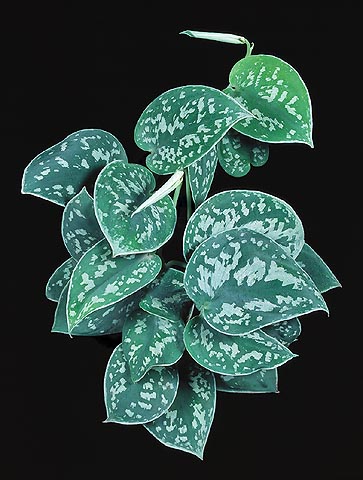Family : Araceae

Text © Pietro Puccio

English translation by Mario Beltramini

Delicate, but of great indoor decorative value © G. Mazza
The name of the genus comes from the Greek “skindapsos” , name under which was indicated a climber similar to the ivy; the name of the species is the Latin word “pictus” = painted, with reference to the grey spots on the leaves.
Common names: “satin pothos”, “silk pothos”, “silver pothos”, “silver vine” (English); “lierre d’argent”, “philodendron picta”, “pothos tacheté” (French); “jibóia-prateada”, “potos-cetim”, “potos-acetinados” (Portuguese); “pothos plateado”, “poto plateado” (Spanish); “Gefleckte Efeutute” (German).
Evergreen climbing herbaceous with thin stems, of about 5 mm of diameter, rooting at the nodes, it presents, when young, rather thick, velvety leaves, ovate-lanceolate with cordate base, slightly asymmetric if compares with the median nervation, 6-8 cm long, on thin petioles, 3-5 cm long, of dark green colour with silvery-grey edge and irregular spots of the same colour on the foliar lamina; when adult, the leaves are cordate, 10-15 cm long and 5-8 cm broad, on short (1,5-2 cm) petioles, always with the silvery-grey dots on the foliar lamina.
Inflorescence formed by a greenish spadix, on which the hermaphrodite flowers are distributed, surrounded by an externally green spathe, with an about 8 cm long, sharp, apex; the fruits are berries containing one seed only, almost kidney-shaped.
It usually reproduces by apical cutting, air layering, or portions of stem, which easily root also in water.
Plant of great ornamental value, mainly utilized for indoor decoration, both as hanging and as climbing on supports covered by bog moss or other material able to keep the humidity.
It needs very porous substrata, draining and rich of organic substance, and temperatures over 14-16°C, best around 18-20°C, and a luminous position, on order to exalt its variegations, but far away from the direct sunlight and the air currents.
Watering must be regular in summer, always avoiding water stagnations which can cause rottenness, with the substratum to be allowed to dry up on the surface between the watering, and reduced in winter, but without drying up completely, the local humidity must be, on the contrary, increased, possibly with nebulisations if in presence of dry air and high temperatures, utilizing non-calcareous water, thus avoiding unaesthetic stains on the leaves.
All the parts of the plant do contain toxic substances, in particular calcium oxalate, which can cause contact dermatitis and even serious reactions if chewed and ingested.
Synonyms: Scindapsus pothoides Schott (1860); Pothos argyraeus Engl. (1879); Scindapsus argyraeus Engl. (1879); Pothos argenteus W.Bull (1887); Scindapsus pictus var. argyraeus (Engl.) Engl. (1898); Scindapsus pictus var. oblongifolius Engl. (1898).
